Pterygotus anglicus
Pterygotus anglicus is a species of the Early Devonian euryptetids (sea scorpions) (order Eurypterida、family Pterygotidae) 4), and has been found in Scottland and Canada 4). Some lineages of eurypterids(order eurypterida) are 2 m or more in length, which are the largest arthropods to have ever found 2), 4).
Although eurypterids are called "sea scorpions" informally and are resemble the extant terresterial scorpions morphologically, they are not specifically the closest relatives 2). Many questions related to the evolution and the phylogeny of eurypterids still remain.
The body length is approximately 1 m. The walking legs (appendages II - V) are slender, the appendage VI is a paddle-shaped swimming leg, and the podomere (coxa) at its base is a gnathobase which is a feeding organ for grinding food 4).
The first appendage is a large chelicera, which can cut prey but is not adapted for crushing, suggesting that Pterygotus was a scavenger that pinched and ate detritus or small animals 4).
The gill covers (the plate-like operculums) bearing the book gills in their inside cover the ventral surface where the air-breathing organ called "Kiemenplatten" is located, indicating that eurypterids were able to breathe on land 3).
The depositional environments in which the specimens were found was a fluvial and these environments may have been partially connected to the marine, suggesting that Pterygotus was freshwater or brackish, such as lagoons or estuaries 4).
The "mas-moult-mate" hypothesis, eurypterids have migrated and molted in a group, and they have adopted the reproductive method using spermatophore transfer on land like did the extant arachnid has been proposed 1). However, masticating food using gnathobase and the paddle-like swimming appendage indicate that their primary habitat was aquatic environment 3). They have sometimes crawled to the land to take advantage of the shallow water and pools as quiet environments during reproduction and molting.
References:
- Braddy SJ, Dunlop JA (1997) The functional morphology of mating in the Silurian eurypterid, Baltoeyrypterus tetragonophthalmus (Fischer, 1839). Zoological Journal of the Linnean Society. 120(4):435-461.(DOI:10.1111/j.1096-3642.1997.tb01282.x.)
- Dunlop JA (2020) Evolution: A Breath of Fresh Air for Eurypterids. Current Biology. 30(21): R1304-R1306. (DOI: 10.1016/j.cub.2020.09.052.)
- Lamsdell JC, McCoy VE, Perron-Feller OA, Hopkins MJ (2020) Air Breathing in an Exceptionally Preserved 340-Million-Year-Old Sea Scorpion. Current Biology. 30(21) 4316-4321.e2. (DOI: 10.1016/j.cub.2020.08.034.)
- Miller RF (2007) Pterygotus anglicus Agassiz (Chelicerata: Eurypterida) from Atholville, Lower Devonian Campbellton Fromation, New Brunswick, Canada. Palaeontology. 50(4): 981-999.(DOI:10.1111/j.1475-4983.2007.00683.x.)

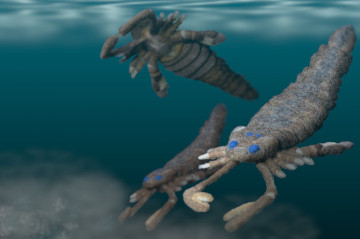
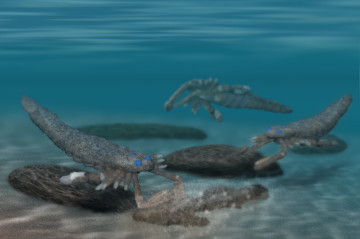
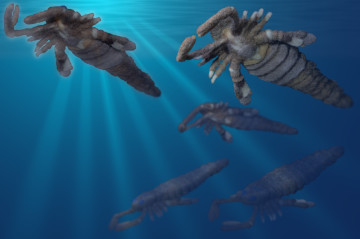
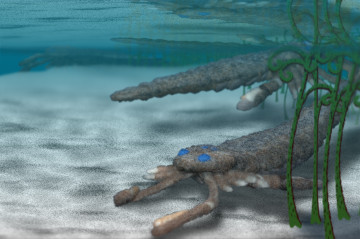
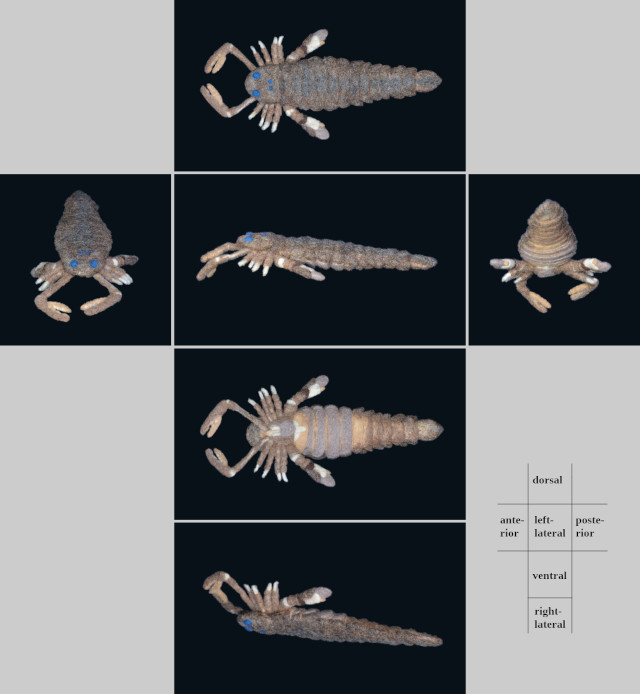
re-created in July - November 2022.